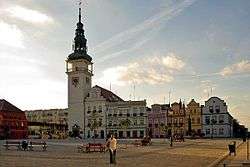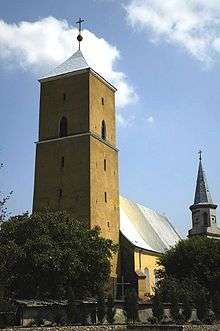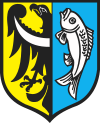Bytom Odrzański
| Bytom Odrzański | |||
|---|---|---|---|
 | |||
| |||
 Bytom Odrzański | |||
| Coordinates: 51°44′N 15°49′E / 51.733°N 15.817°E | |||
| Country |
| ||
| Voivodeship | Lubusz | ||
| County | Nowa Sól | ||
| Gmina | Bytom Odrzański | ||
| Government | |||
| • Mayor | Jacek Sauter | ||
| Area | |||
| • Total | 10 km2 (4 sq mi) | ||
| Population (2006) | |||
| • Total | 4,365 | ||
| • Density | 440/km2 (1,100/sq mi) | ||
| Postal code | 67-115 | ||
| Website | http://www.bytomodrzanski.pl/ | ||
Bytom Odrzański [ˈbɨtɔm ɔˈdʐaɲskʲi] (German: Beuthen an der Oder) is a town on the Oder river in western Poland, in Nowa Sól County of Lubusz Voivodeship.
History

Archaeological findings from the Stone Age and Bronze Age around Bytom suggest an early settlement. A Slavic gród is mentioned in 1005.[1] During invasion of Poland by Henry V, Polish ruler Bolesław III Wrymouth successfully defended the settlement in August 1109.[2][3] The chronicles of Gallus Anonymus dedicate a lengthy passage concerning the battle, and praising the strong defense of the settlement and bravery of its defenders.[4] This battle and Gall's praise is mentioned today on the main site of the town[5]
A medieval castellany is first mentioned in 1203 on a ford crossing the Oder, held by the Silesian Piasts. During inheritance conflict of Polish high duke Bolesław IV the Curly with the sons of his elder brother Władysław II the Exile and Emperor Frederick Barbarossa the town was abandoned by Polish troops, due to its state of neglect,[6] and burned down to prevent enemy from using its food supplies as well as having a place to rest[7] The parish church was a filial of the Cistercian Abbatia Lubensis abbey and first documented in 1175. The settlement itself was granted German town law in 1263 and subsequently experienced arrival of immigrants during the Ostsiedlung.
In 1475 Beuthen belonged to merchant Andreas Neumann (75%) and Georg von Glaubitz (25%). Johann von Rechenberg acquired both parts in 1524 and introduced the Protestant Reformation to the town. In 1540 the first Protestant pastor was appointed. In 1561 Franz von Rechenberg sold Beuthen to Fabian von Schoenaich. Von Schoenaich fought on the Catholic side in the Schmalkaldic War, but protected the Protestants in his domain. His cousin and successor Georg von Schoenaich made great contributions to the development of the town by the cultivation of the right bank of the Oder river, the planting of several fruits and grapes and the building of a new town hall (1602) and a bridge across the Oder. In 1618 a Protestant chapel was built, which was closed after the Thirty Years' War by imperial order in 1653. The biggest achievement by Georg von Schoenaich however was the establishment of a humanist Gymnasium academicum school in 1601. The school had 12 chairs, among them one for Protestant theology, for jurisprudence, medicine and - a novelty - morals. Between 1609 and 1613 a new school house was built. One of the gymnasiums students was Martin Opitz, who wrote his Aristarchus, sive De contemptu linguae Teutonicae there, which presented the German language as suitable for poetry. In 1628 the school however was already closed again by imperial order, since the gymnasium was considered Calvinistic.
Beuthen was fortified in 1616 by fortress master Andreas Hindenberger. During the Thirty Years' War winter king Frederick V allegedly stayed overnight on his flight from Bohemia. After the occupation of the town by Liechtenstein dragoons Beuthen was recatholized by force in 1628. The Stephans church and the hospital were taken from the Protestants in 1653. A fire in 1694 destroyed parts of the town and the town hall, which was rebuilt in 1696.
The town was raised to the status of a state country by decree of Emperor Leopold I of Habsburg in 1697. After Frederick II of Prussia seized Silesia the Protestant school was opened again, and between 1744 and 1746 a Protestant church was built. Between 1766 and 1884 it was a garrison town. During the late 19th century brown coal mining became an important pillar of the local economy. The Prussian state railways opened a connection to Beuthen in 1871.
In 1945 40% of the town were destroyed. Beuthen, along with Former eastern territories of Germany, passed to Poland. The town was renamed to Bytom Odrzański.
Notable people
- Martin Opitz (1597–1639) attended the gymnasium at Bytom in 1617
- The journalist and writer Jochen Klepper (1903–1942) was born here.
Twin town
Bytom Odrzański is twinned with:
-
 Pößneck, Germany
Pößneck, Germany
References
- ↑ Archeologia po drodze:przewodnik Tadeusz Baranowski, Wiesław Zajączkowski Wydawnictwo Polskiej Akademii Nauk, 1976 page 24
- ↑ Popularnonaukowa biblioteka archeologiczna , Wydanie 19 Polskie Towarzystwo Archeologiczne, Polskie Towarzystwo Archeologiczne i Numizmatyczne Zakład Narodowy im. Osslińskich, 1976 page 24
- ↑ Polska, losy państwa i narodu Henryk Samsonowicz Iskry, 1992 page 49
- ↑ Miasta polskie w tysiącleciu, Tom 2 Zakład Narodowy im. Ossolińskich, 1965 Mateusz Siuchniński page 623
- ↑ Bytom Odrzański - Home
- ↑ Słownik władców Polski i pretendentów do tronu polskiego Marcin Spórna, Piotr Wierzbicki, Edyta Wygonik Wydawn. Zielona Sowa, 2003 page 68
- ↑ Książęta piastowscy Śląska Zygmunt Boras "Śląsk", 1982 page 33
External links
| Wikimedia Commons has media related to Bytom Odrzański. |
Coordinates: 51°44′N 15°50′E / 51.733°N 15.833°E

